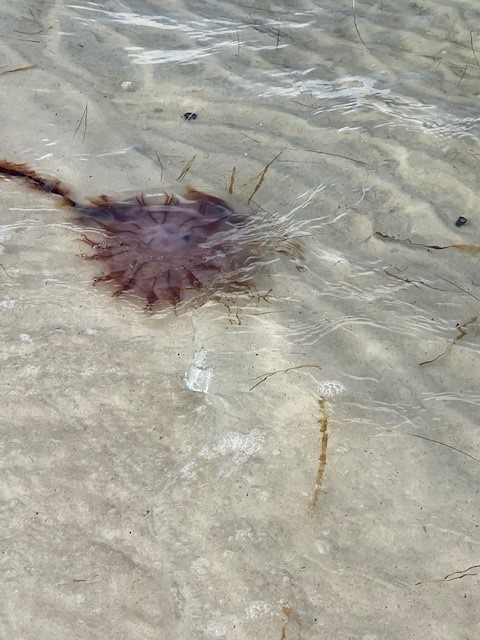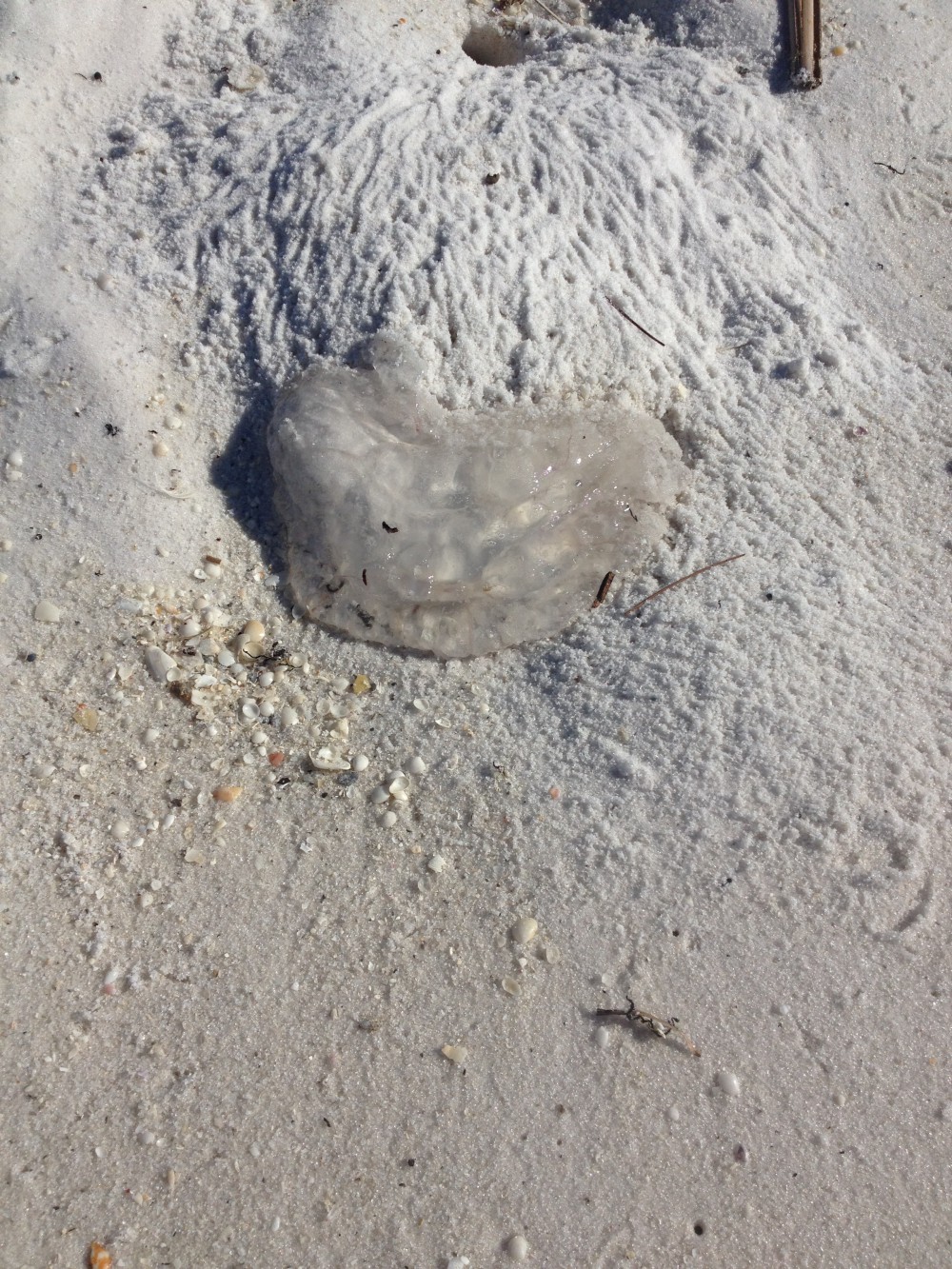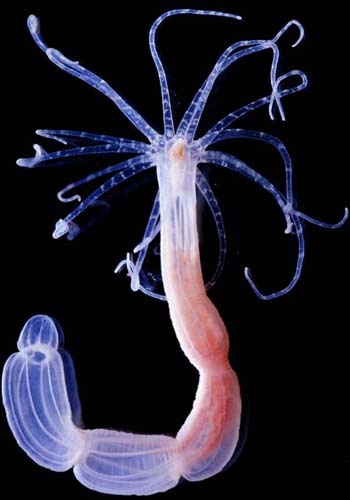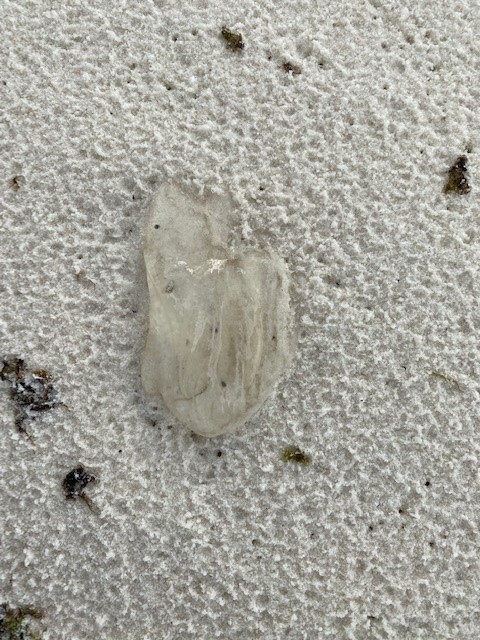Many of the creatures we have written about in this series to this point are ones that very few people have ever heard of. But that is not the case with jellyfish. Everyone knows about jellyfish – and for the most part, we do not like them. These are the gelatinous blobs with trailing tentacles filled with stinging cells that cause pain and trigger the posting of the purple warning flags at the beach. They are creatures that many place in the same class as mosquitos and venomous snakes – why do such creatures even exist. But exist they do and there are plenty in the northern Gulf – more than you might be aware of.
The ones we are familiar with are those that are gelatinous blobs with trailing tentacles – called medusa jellyfish. These include the common sea nettle (Chrysaora). Sea nettles have bells about 4-8 inches in diameter (though they are larger offshore). The bell has extended triangle markings that appear red and tentacles that can extend several feet beneath/behind the bell. The tentacles are armed with nematocyst – cells that contain a coiled “harpoon” which has a drop of venom at the tip. They use these nematocyst to kill their prey – which include small fish, zooplankton, and comb jellies. But they are also triggered when humans bump into them producing a painful sting. Their prey is digested in a sack-like stomach called the gastrovascular cavity and waste is expelled through their mouth, because they lack an anus. Though these animals can undulate their bells and swim, they are not strong enough to swim against currents and tides – and thus are more planktonic in nature.
Another familiar jellyfish is the moon jelly (Aurelia). These are the larger, saucer shaped jellyfish that resemble a pizza with a clover leaf looking structure in the middle. They can reach 24 inches in diameter across the bell which is often seen undulating trying to swim against the current and tide. Their tentacles are very short – extending from the rim of the bell – but there are four large oral arms that are quite noticeable. The oral arms also possess nematocyst for killing prey. Their prey includes mostly zooplankton and other jellyfish. Like their cousins the sea nettles, moon jellies are planktonic in nature and are often found washed ashore during high energy days. Some say the pain from this jellyfish is minimal, others feel a lot of pain.
Though there are many others, our final familiar jellyfish would be the Portuguese man-of-war (Physalia). If you have never seen one, you most likely have heard of them. These are easy to identify. They produce a bluish colored gas filled balloon like sack that floats on the surface and extends above water to act as a “sail”. This gas filled sack is called a pneumatophore and helps move the animal across the Gulf. Extending down from this pneumatophore are numerous purple to blue to clear colored tentacles. You would think the pneumatophore would be the bell of the jellyfish and the tentacles of similar design as to the ones we mentioned above – but that would be incorrect. The tentacles are actually a colony of small polyp jellyfish connected together – it is not a true jellyfish (as we think of them). The stomachs of these individual polyps are connected and as one kills and feeds, the food passes throughout the colony to nourish all. In order to feed the whole colony, you need larger prey. To kill larger prey, you need a more toxic venom, and PMOW do have a very strong toxin. The sting from this animal is quite painful – though rare, it has even killed people. This jellyfish should be avoided. As with other jellyfish, they often wash ashore, and their stinging cells can still be triggered. Do not pick them up.
There is another form of jellyfish found here that is not as well known. They may be known by name, but not as jellyfish. They are called polyp jellyfish and instead of having an undulating bell with tentacles drifting behind, they are attached to the seafloor (or some other structure) and extend their tentacles upward. They look more like flowers and do not move much. Examples of such jellyfish include the tiny hydra, sea anemones, and corals. As with their medusa cousins, they do have nematocysts in their tentacles and can provide a painful sting, though some produce a mild toxin, and the sting is not as painful as other jellyfish. Many of these polyp jellyfish are associated with coral reefs. Though coral reefs are common in tropical waters, they do occur to a lesser extent in the northern Gulf.
We will complete this article with a group of jellyfish that do not have nematocysts and, thus, do not sting – the comb jellies. Though many species of comb jellies have trailing tentacles, the local species do not. When I was young, we called them “football jellyfish” because of their shape – and the fact that you could pick them up and throw them to your friends. I have also heard them called “sea walnuts” because of their shape. A close look at this jellyfish you will see eight grooves running down its body. These grooves are filled with a row of cilia, small hairlike structures that can be moved to generate swimming. The cilia move in a way that they resemble the bristles of a comb we use for combing our hair. You have probably taken your thumb and run it down your comb to see the bristles bend down and back into position – sort of like watching the New York Rockettes high kick from one end of their line to the other – this is what the cilia look like when they are moving within these grooves – and give the animal its common name “comb jelly”. Since they do not have nematocysts, they are in a different phylum than the common jellyfish. They feed on plankton and each other and can produce light – bioluminescence – at night.
Though not loved by swimmers in the northern Gulf, jellyfish are interesting creatures and beautiful to watch in public aquaria. They have their bright side.
References
Atlantic Sea Nettle. Aquarium of the Pacific. https://www.aquariumofpacific.org/onlinelearningcenter/species/atlantic_sea_nettle1.
Moon Jellyfish. Animal Diversity Web. University of Michigan Museum of Zoology. https://www.aquariumofpacific.org/onlinelearningcenter/species/atlantic_sea_nettle1.
- Our Environment: Part 23 – Hydrogen as an Energy Source - October 29, 2025
- Nurse Shark Spotted in Big Lagoon - October 21, 2025
- Our Environment: Part 22 – Geothermal Energy - October 21, 2025




